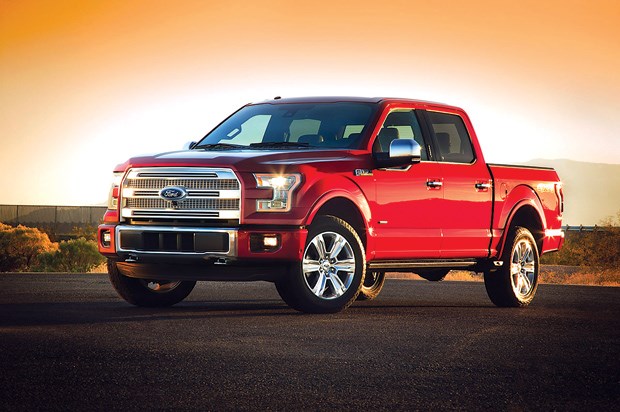A biweekly roundup of automotive news, good, bad and just plain weird:
Ford's aluminium F-150 challenges body shops, junkyards
Don your tinfoil hats, here comes the 2015 Ford F-150, and it's mostly made from aluminium. While the best-selling vehicle in North America has had some aluminium body pieces for years - notably, the hood - this is the first time the truck will have the material forming most of its skin.
Lighter than steel, but just as strong, aluminium is quite expensive, and difficult to form. It is, however, very recyclable and the potential weight savings are huge. Ford isn't announcing any figures for their next-generation F-150 just yet, but curb weights should be down significantly, and payload and fuel economy up.
However, the decision to make the single most popular vehicle in North America out of aluminium is going to have some longlasting repercussions. This is no limited production Audi R8 - nearly a million F-150s were sold in the U.S. and Canada last year.
As you can't really take dents out of an aluminium door panel (think of trying to smooth out a sheet of tinfoil), insurance rates for the truck are going to go up. More problematic, not all body shops have the particular tools to work with the material, meaning that those that do are going to get a lot busier.
Moreover, the old picka- part is going to change too. Aluminium is worth far more than steel as a recyclable material, and as more manufacturers follow Ford's lead, there'll be less scavenging at junkyards as wrecked cars go straight to the crusher and the recycling line.
It's not all doom and gloom however, just a change in the traditional model brought about by some long overdue progress. How Ford's gamble will pay off in the years to come isn't clear, but it's worth watching.
Alessandro Zanardi climbs back in the racing seat
Alessandro "Alex" Zanardi is an Italian racing driver with a superhuman urge to compete. Successful at the pinnacle of motorsport - Formula One - Zanardi also won two CART championships and even has his own racing manoeuvre.
The Zanardi Line, as it's known, involves divebombing the competition through one of the most well recognized turns in the world: the Corkscrew at Laguna Seca. Now banned, Zanardi pulled this inside pass to take the win in 1996, cementing his reputation as a risk taker and champion.
Then, in 2001, tragedy struck as Zanardi was involved in a terrible crash that resulted in a double leg amputation. For a normal person, this would be the end of any motorsports competition.
Not only did Zanardi bounce back to the track, racing a touring car again just a few years later and testing a Formula One racer fitted with hand controls, he took up the sport of hand cycling, and recently took home two Olympic gold medals at the London Paralympics.
Once again, the unstoppable Italian is getting behind the wheel of a racing car fitted with special controls, a BMW Z4 GT3. Zanardi will be racing full-time in the Blancpain Sprint Series, starting in April.
Mini rallies to victory at Dakar
With gents like Paddy Hopkirk at the wheel, the original Mini Cooper was an unlikely rallying success in the 1960s. This plucky little car out-handled the big boys, and scrappily took home trophy after trophy.
These days, of course, Mini doesn't have anything like the same competitive spirit, right? I mean, they're all about selling fat little crossovers like the Countryman and really expensive, BMW-built, upscale compact luxury.
Um, no, actually. At this year's incredibly gruelling Dakar rally in South America, a Mini team came first. And second. And third.
Sweeping the podium is no mean feat, and to pull it off after driving across nearly 10,000 kilometres of sand and gravel is extremely impressive. The trio of Mini ALL4s crossed the Andes, deserts filled with treacherous dunes, and plains strewn with pointy rocks.
Naturally, you can't really buy a Mini that's spec'd appropriately to handle desert crossings down at your local dealership, but it's nice to know that they haven't lost their touch.
Nissan mulling Datsun 510 successor
The pair of IDx concepts shown at the Tokyo and Detroit auto shows looked suitably futuristic and improbable, but there are plans afoot. According to Nissan product planner Andy Palmer, Nissan might actually build this car.
In shape, the IDx looks a little like the mini-muscle of the old Datsun 610, a cousin of the 510. Based on industry scuttlebutt, the enormous amount of interest that the car is generating is causing Nissan to weigh options for building a rear-wheeldrive, lightweight sedan, something that hasn't really been seen for years.
The 510 made Datsun a success, perhaps even more so than the svelte 240Z. While the latter was a style icon, the 510 was a car you could actually afford and haul the family around in. It was a Japanese answer to lightweight German rivals like the BMW 2002, and it has a cult following even today.
While the IDx concepts are chunky two-door coupes, there's some hope that the car won't end up as another 2+2 sports car to challenge the Scion FR-S, but emerge as a lightweight sports sedan, perhaps powered by Nissan's peppy 1.6-litre turbo. Even though it's just rumours at this point, it's good to know that manufacturers seem to recognize that there's a need for smaller, lighter cars that capture some of that oldfashioned driving fun.
Watch this space for all the week's best and worst of automotive news, or submit your own auto oddities to [email protected]. Follow Brendan on Twitter at @brendan_mcaleer.



